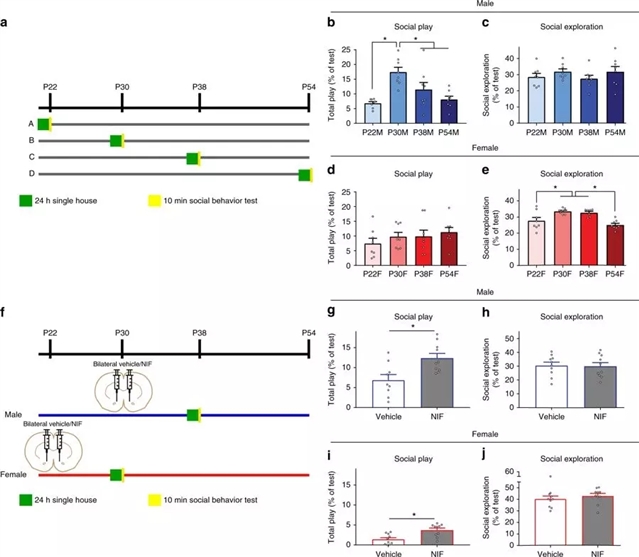论文标题:Microglial dopamine receptor elimination defines sex-specific nucleus accumbens development and social behavior in adolescent rats
期刊:Nature Communications
作者:Ashley M. Kopec, Caroline J. Smith, Nathan R. Ayre, Sean C. Sweat & Staci D. Bilbo
发表时间:2018/09/25
数字识别码:10.1038/s41467-018-06118-z
原文链接:https://www.nature.com/articles/s41467-018-06118-z?utm_source=Other_website&utm_medium=Website_links&utm_content=RenLi-MixedBrand-multijournal-Multidisciplinary-China&utm_campaign=ORG_USG_JRCN_RL_article_promotion_sciencenet_Oct_2nd
微信链接:https://mp.weixin.qq.com/s/YgcZ7KMwmrjQj3JYNKPbjg
《自然-通讯》近日发表的一项研究Microglial dopamine receptor elimination defines sex-specific nucleus accumbens development and social behavior in adolescent rats指出,青春期雄性大鼠“追逐打闹”的社会玩耍行为受到大脑中免疫细胞的控制。这项研究结果有助于更好地理解性别特异性行为以及大脑在接近成年前的发育方式。

图1:青春期的多巴胺D1受体下调与雄性(非雌性)的补体C3和小胶质细胞吞噬相关。
图源:Kopec等
科学家最近发现,一种名为“小胶质细胞”的免疫细胞有助于对发育中的脑回路进行塑造。婴儿出生后,小胶质细胞会很快开始包围或“吞噬”突触(突触是神经元交流的连接部位),清除脑内多余突触。不同性别的小胶质细胞特性也不同,不过,科学家仍在探索这种差异会如何改变行为以及后期发育。
美国麻省总医院儿童医院的Ashley Kopec、Staci Bilbo及同事发现,雄性大鼠在接近青春期时,会短暂性地大量出现猛扑、把对方按住或骑在对方背上的玩耍行为。作者发现,小胶质细胞通过吞噬能探测到多巴胺(大脑中的一种化学“奖励”信号)的突触,可以结束雄性大鼠这种暂时性的玩耍行为。研究人员用名为C3的分子为这些需要清除的突触进行标记。此外,虽然雌性大鼠青春期的社会玩耍行为不会出现这种激增,但小胶质细胞似乎仍能影响这些玩耍行为,只不过作用方式并非通过吞噬能探测到多巴胺的突触。

图2:青春期性别特异的社会行为模式需要C3和C3受体之间的相互作用。图源:Kopec等
想要解释小胶质细胞如何改变雌性大鼠的玩耍行为需要开展FC碰碰胡老虎机法典-提高赢钱机率的下注技巧研究;此外,小胶质细胞能否调节人类的社会行为也不确定。不过,作者指出,这项研究结果或有助于进一步理解青少年大脑发育和性别特异性发育,并为将来认识成年早期的大脑疾病或因性别而异的大脑疾病提供了铺垫。
摘要:Adolescence is a developmental period in which the mesolimbic dopaminergic “reward” circuitry of the brain, including the nucleus accumbens (NAc), undergoes significant plasticity. Dopamine D1 receptors (D1rs) in the NAc are critical for social behavior, but how these receptors are regulated during adolescence is not well understood. In this report, we demonstrate that microglia and complement-mediated phagocytic activity shapes NAc development by eliminating D1rs in male, but not female rats, during adolescence. Moreover, immune-mediated elimination of D1rs is required for natural developmental changes in male social play behavior. These data demonstrate for the first time that microglia and complement-mediated immune signaling (i) participate in adolescent brain development in a sex-specific manner, and (ii) are causally implicated in developmental changes in behavior. These data have broad implications for understanding the adolescent critical period of development, the molecular mechanisms underlying social behavior, and sex differences in brain structure and function.
阅读论文全文请访问:https://www.nature.com/articles/s41467-018-06118-z?utm_source=Other_website&utm_medium=Website_links&utm_content=RenLi-MixedBrand-multijournal-Multidisciplinary-China&utm_campaign=ORG_USG_JRCN_RL_article_promotion_sciencenet_Oct_2nd
期刊介绍:Nature Communications (https://www.nature.com/ncomms/) is an open access journal that publishes high-quality research from all areas of the natural sciences. Papers published by the journal represent important advances of significance to specialists within each field.
The 2017 journal metrics for Nature Communications are as follows:
•2-year impact factor: 12.353
•5-year impact factor: 13.691
•Immediacy index: 1.829
•Eigenfactor® score: 0.92656
•Article Influence Score: 5.684
•2-year Median: 8
(来源:科学网)
特别声明:本文转载仅仅是出于传播信息的需要,并不意味着代表本网站观点或证实其内容的真实性;如其他媒体、网站或个人从本网站转载使用,须保留本网站注明的“来源”,并自负版权等法律责任;作者如果不希望被转载或者联系转载稿费等事宜,请与我们接洽。